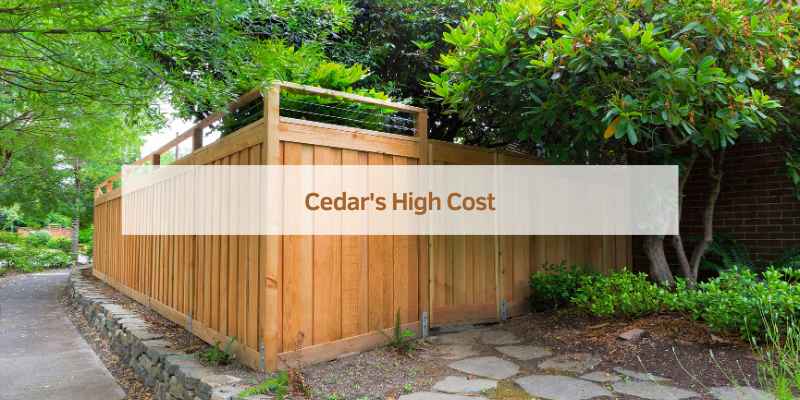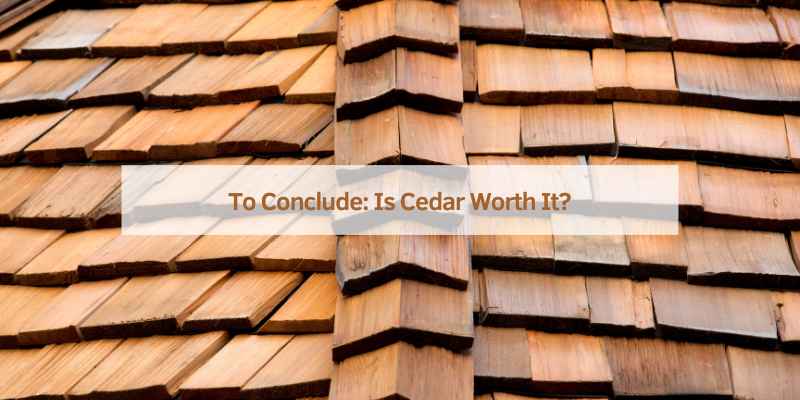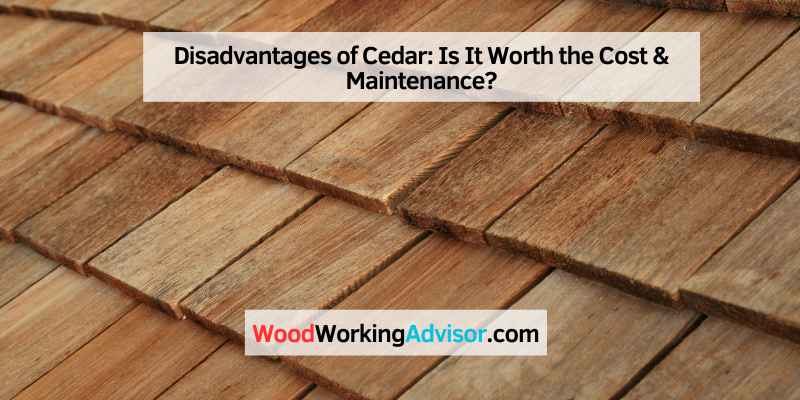Cedar wood has a few disadvantages, including its tendency to degrade quickly when used for ground-level decks and its susceptibility to drying out when shaded. Additionally, cedar can become dented easily, is more expensive compared to other wood types like pine, and requires regular maintenance to prevent fading of its color due to chemical reactions.
Despite these drawbacks, cedar is known for its resilience, resistance to moisture and insects, and durability. It is commonly used in cabinets, furniture, building construction, and as cedar shakes and shingles due to its low shrinkage factor and superior resistance to warping, twisting, and checking.
Cedar’s High Cost
Cedar wood is renowned for its natural beauty and durability, but one significant drawback is its high cost. When compared to other types of wood commonly used in construction and woodworking, cedar tends to come with a premium price tag.
Price Comparison With Other Woods
When considering the cost of cedar, it’s important to compare it to alternative wood options. Cedar is notably more expensive than popular choices like pine, oak, and spruce. This higher price point can make cedar less accessible for budget-conscious projects.
Long-term Investment Analysis
Despite its initial high cost, cedar can be viewed as a long-term investment due to its durability and resistance to rot and insects. Over time, the minimal maintenance requirements and extended lifespan of cedar may justify the higher upfront expenses.

Durability Concerns
Cedar wood, while durable under optimal conditions, can degrade more quickly when used for ground-level decks and if it’s shaded, leading to durability concerns. This type of wood may require regular maintenance and can be more susceptible to dents and fading compared to other hardwoods, making it important to weigh the disadvantages against its benefits.
Susceptibility To Deterioration
One of the main durability concerns when it comes to cedar is its susceptibility to deterioration. While cedar is known for its longevity under ideal conditions and proper treatment, it tends to degrade more quickly when used for ground-level decks. This is due to its exposure to moisture and direct contact with the ground, which can lead to rot and decay over time.
Ground-level Decks And Shaded Areas
Cedar decks that are built at ground level are particularly vulnerable to durability issues. The proximity to the ground increases the chances of moisture accumulation, which can speed up the deterioration process. Additionally, if the deck is shaded and does not receive enough sunlight, the cedar wood will slowly dry out, making it more prone to cracking and splitting.
In conclusion, while cedar is a popular choice for outdoor structures due to its natural beauty and resistance to insects, it is important to be aware of its durability concerns. Ground-level decks and shaded areas are more susceptible to deterioration, which can lead to rot, decay, and other structural issues over time. Regular maintenance and proper treatment can help prolong the lifespan of cedar, but it is important to weigh the disadvantages against the desired aesthetic and natural properties of this type of wood.
Warping And Twisting
One of the significant drawbacks of cedar wood is its susceptibility to warping and twisting, which can affect its structural integrity and aesthetic appeal.
Resistance To Deformation
Cedar is known to be relatively resistant to warping, making it a popular choice for various applications. However, under certain conditions, cedar wood can still be prone to deformation.
Conditions Leading To Warping
Several factors can contribute to the warping and twisting of cedar wood, including:
- Inconsistent moisture levels
- Exposure to extreme temperature fluctuations
- Improper storage or installation
It is essential to address these conditions to prevent warping and ensure the longevity of cedar wood products.
Moisture Effects
Cedar, despite its many advantages, is not without its drawbacks. One of the key disadvantages of cedar is its susceptibility to moisture, which can lead to a range of issues.
Hygroscopic Nature Of Cedar
Cedar is known for its hygroscopic nature, meaning it has the ability to absorb and release moisture in response to changes in the surrounding environment. This can result in the wood expanding and contracting, leading to potential warping, twisting, and checking.
Equilibrium With Environment
Western Red Cedar, like all woods, will seek to attain equilibrium with the surrounding atmosphere by absorbing or discharging moisture. While it has a low shrinkage factor and is resistant to warping and twisting, it is still susceptible to moisture-related issues if not properly maintained.
Rot Resistance
Cedar’s Battle Against Rot
Cedar is often praised for its natural resistance to rot, making it a popular choice for outdoor applications such as fencing, decking, and siding. However, it’s important to understand that cedar is not immune to decay, and there are several factors that can impact its longevity.
Factors Affecting Cedar’s Longevity
Despite its inherent resistance to decay, cedar’s longevity can be influenced by various factors. Exposure to moisture, especially when used in ground-level applications, can accelerate the rotting process. Additionally, shaded areas can contribute to the slow drying of cedar, making it more susceptible to decay over time.
Maintenance Requirements
Cedar wood, despite its durability, has drawbacks like susceptibility to dents and fading color, requiring regular upkeep. This softwood may not outlast other hardwoods and can be easily damaged. Regular maintenance is essential to preserve its appearance and longevity.
Cedar wood is a popular choice for outdoor furniture, decks, and siding due to its natural beauty and durability. However, it does require regular upkeep to maintain its appearance and prevent damage. Here are some of the maintenance requirements and disadvantages of cedar wood:
Regular Upkeep Necessities
Cedar wood needs to be sealed or stained regularly to protect it from moisture and UV rays. Without proper maintenance, it can become discolored, warped, and cracked. Regular cleaning is also necessary to remove dirt, debris, and mildew that can accumulate on the surface.
Color Fading And Chemical Reactions
One of the drawbacks of cedar wood is that its natural color can fade over time due to exposure to the sun and other elements. This can be prevented with regular staining or sealing, but it can be time-consuming and costly. Additionally, cedar wood is sensitive to certain chemicals, such as bleach and ammonia, which can cause discoloration and damage to the wood.
While cedar wood is a beautiful and durable material for outdoor use, it does require regular maintenance to keep it looking its best. Homeowners should be prepared to invest time and money into sealing, staining, and cleaning their cedar wood to prevent damage and maintain its natural beauty.
Physical Damage
Cedar, while a popular choice for its natural beauty and durability, is not without its drawbacks. One significant disadvantage is its susceptibility to physical damage, particularly in the form of scratches, dents, and impact from furniture and pets.
Scratch And Dent Potential
Cedar decking, being a softer wood, is more prone to scratches and dents compared to harder woods. This makes it susceptible to damage from everyday wear and tear, diminishing its aesthetic appeal and longevity.
Impact Of Furniture And Pets
The presence of furniture and pets in a cedar-clad environment can pose a threat to the wood’s integrity. Furniture legs and pet claws can leave unsightly marks and cause structural damage to the cedar, detracting from its overall quality.
Cedar In Outdoor Use
When it comes to using cedar for outdoor applications, it’s important to consider the potential disadvantages. While cedar is often praised for its natural beauty and durability, there are certain drawbacks to using this wood in outdoor settings, especially when compared to other materials.
Comparative Outdoor Performance
Cedar is a popular choice for outdoor use due to its natural resistance to rot, decay, and insects. However, it’s important to note that cedar may not always live up to its reputation under certain conditions. For instance, when used in ground-level decks or in shaded areas, cedar tends to degrade more quickly and may dry out, leading to potential warping and deterioration.
Cedar Vs. Pressure Treated Wood
When comparing cedar to pressure-treated wood for outdoor use, it’s essential to weigh the pros and cons of each. While cedar offers natural resistance to rot and insects, pressure-treated wood is specially treated to withstand these outdoor elements, making it a more durable option in some cases. Additionally, pressure-treated wood may offer better longevity and require less maintenance compared to cedar in certain outdoor applications.
Alternatives To Cedar
Cedar wood has its disadvantages, including potential deterioration concerns when used for ground-level decks and a tendency to dry out if shaded. It is also more prone to warping compared to other woods. Regular maintenance is required to prevent color fading due to chemical reactions.
However, cedar is still a popular choice for its durability and resistance to rot.
While cedar is a popular choice for outdoor structures such as decks and fences, it does come with its fair share of disadvantages. These include deterioration concerns, susceptibility to warping when wet, and the need for regular maintenance. As such, it’s worth considering some alternatives to cedar when planning your next outdoor project.
Comparing Other Wood Species
One alternative to cedar is pressure-treated lumber, which is resistant to decay and insects. However, it can be more difficult to work with and may contain chemicals that are harmful to the environment. Redwood is another option, known for its durability and resistance to decay. However, it can be expensive and may not be available in all areas. Other wood species to consider include tropical hardwoods like ipe or mahogany, which are known for their strength and durability.
Considering Composite Materials
If you’re looking for a low-maintenance alternative to wood, composite materials may be the way to go. Made from a combination of wood fibers and plastic, composite decking is resistant to rot and insects and doesn’t require staining or sealing. However, it can be more expensive than wood and may not have the same natural look and feel.
Ultimately, the right choice for your outdoor project will depend on your budget, location, and personal preferences. By considering the advantages and disadvantages of different materials, you can make an informed decision that will help you create a beautiful and long-lasting outdoor space.
To Conclude: Is Cedar Worth It?
While cedar is praised for its durability, it can deteriorate quicker in ground-level applications and shaded areas. Regular maintenance is needed to prevent fading and damage. Cedar’s softer nature makes it susceptible to scratches and dents compared to other hardwoods.
Weighing Pros And Cons
Before deciding whether cedar is worth it for your project, it’s important to consider the advantages and disadvantages. While cedar offers many benefits such as natural beauty and resistance to insects, it also comes with its own set of drawbacks. Understanding the pros and cons will help you make an informed decision.
Making The Right Choice For Your Needs
When it comes to choosing the right wood for your project, it’s essential to evaluate your specific requirements. Consider factors like durability, maintenance, and cost to determine if cedar is the best fit for your needs. By weighing the pros and cons and understanding your project’s demands, you can make a decision that aligns with your goals.
To conclude, is cedar worth it?
While cedar offers numerous benefits, including its natural beauty and insect resistance, it’s essential to weigh these advantages against its disadvantages. By carefully considering your specific requirements and evaluating the pros and cons, you can make an informed decision that aligns with your project’s needs.

Frequently Asked Questions
What Are The Negatives Of Cedar?
Cedar wood tends to degrade quickly when used for ground-level decks and if it’s shaded, it will slowly dry out. Additionally, it requires regular maintenance as the color may fade away due to a chemical reaction. However, cedar is relatively resistant to warping and insects, making it a popular choice for outdoor structures like fences and decking.
Does Cedar Warp Easily?
Cedar is resistant to warping, known for durability, moisture repellent, and commonly used in various applications.
What Happens To Cedar When It Gets Wet?
When cedar gets wet, it absorbs moisture and may slowly dry out if shaded. It has a low shrinkage factor and is resistant to warping, twisting, and checking. However, cedar is not immune to rot and may deteriorate over time if not properly maintained.
Can Cedar Wood Rot?
Cedar wood is known for its durability and resistance to rot, making it a popular choice for outdoor structures. However, cedar is not immune to rot, and over time, even cedar posts can deteriorate. It is important to regularly maintain cedar to prevent fading and potential damage.
Despite this, cedar remains a preferred option due to its natural resistance to moisture and insects.
Conclusion
While cedar is durable and rot-resistant, it can degrade quickly in certain conditions. Cedar may warp, fade, and require regular maintenance, making it less practical for some projects. Consider these drawbacks when choosing cedar for your outdoor structures.


